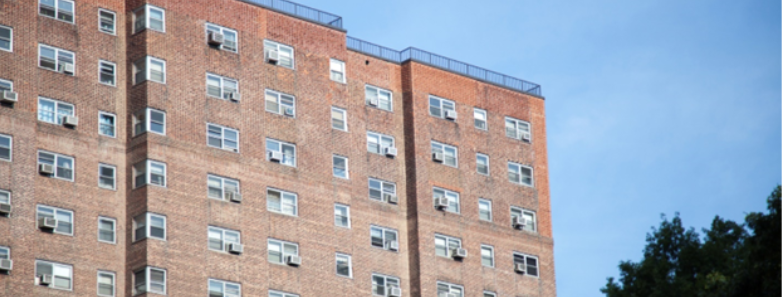Room to Breathe: Lessons from Atlanta’s First Healthy Housing Program

By Laura Diaz-Villaquiran

SEEA is excited to share the results of the Room to Breathe pilot program that we led alongside the Atlanta Volunteer Lawyers Foundation (AVLF) and SK Collaborative. Room to Breathe, which ran from 2021 to 2023, was the first healthy housing program in the City of Atlanta to provide low-income renters with efficiency and healthy housing assessments. By helping renters access energy and health testing for their homes as well as legal aid services, this program facilitated health and safety upgrades and supported those at risk of eviction.
This program underscored the deeply interconnected nature of energy insecurity, housing insecurity, housing quality, health, and occupant safety. Diana Hernández has introduced the concept of energy insecurity, a framework that highlights how unaffordable energy costs and the inability to maintain essential energy services can force individuals to make difficult choices, such as sacrificing food and medicine.1 In this program, participating households were energy insecure, and tended to live in energy-inefficient homes, often under the looming threat of eviction—conditions strongly associated with negative health outcomes, including respiratory problems.
Recognizing these interconnected challenges, our pilot program was designed to address both housing quality and energy efficiency issues, with a focus on improving the affordability, health, and sustainability of housing. We believe this is a promising model for supporting low-income renters who face steep barriers to accessing assistance for home repairs and energy efficiency upgrades.
Program Model

Figure 1. Room to Breathe program model. This model can be replicated without the large outlays of start-up capital required for most energy efficiency or healthy housing programs.
Renters who had reached out to AVLF for legal assistance were pre-screened through an over-the-phone questionnaire that evaluated if the household was a candidate for an in-depth home assessment. SK collaborative staff visited participating households where they evaluated the home’s indoor air quality and energy efficiency. Each assessment consisted of a thorough visual inspection, performance testing to quantify HVAC, duct, and envelope leakage, and combustion safety testing to examine the potential for exposure to natural gas and carbon monoxide. Reports of all findings were prepared by SK Collaborative and used by AVLF’s pro-bono attorneys to advocate for tenants’ needs. These reports were instrumental in halting impending evictions and securing home repairs for more than half of participating households.
Project Findings
A review of all 11 home assessments revealed patterns of inadequate housing conditions, potential health and safety hazards, and energy inefficiencies in participating homes.
The following were the most frequently reported issues, as indicated in Figure 2:
- All homes showed evidence of water damage, and SK Collaborative’s reports identified damage to the roofs, ceilings, floors, walls, and in some cases, foundations.
- 80% of homes exhibited damage to the building envelope, such as gaps, holes, and penetrations.
- 80% of homes had excessive dust, suspected microbial growth, and evidence of pests, such as roaches and rodents.
- Half of the homes had inadequate weatherstripping around doors and windows, leading to air leakage.
- 50% of homes had an air filter in poor condition at the central HVAC system.
- 30% of participating households had a missing air filter from the central HVAC system.
- 30% of households also reported that a child in the home suffered from respiratory issues.

Figure 2. Home Assessment Results. This figure highlights the common housing quality challenges observed across participating households.
Lessons Learned and Future Work
Room to Breathe is a replicable and cost-effective model, developed through a collaborative effort between AVLF, SK Collaborative, and SEEA. Its success demonstrates that significant improvements in health and housing can be achieved without substantial upfront costs often needed in energy efficiency and healthy housing programs.
Our vision is to expand this model across the Southeast, increasing resilience for vulnerable households. By scaling up programs like Room to Breathe, we can enhance housing affordability, improve energy efficiency, and reduce negative health outcomes, driving meaningful change in both housing quality and public health.
Follow this link to read the full report
About SEEA:
The Southeast Energy Efficiency Alliance (SEEA) is a nonprofit organization committed to advancing energy efficiency in the Southeast to create a cleaner, more resilient, and equitable energy future. By fostering collaboration among diverse stakeholders and providing technical expertise, SEEA drives impactful energy efficiency initiatives across the region.
About SK Collaborative:
SK Collaborative provides practical, cost-effective solutions to meet building certification standards for developers, builders, contractors, architects, and homeowners. Their services include consulting, design reviews, training, building certification, and inspections to enhance efficiency, health, and durability in projects. With over 25,000 single and multifamily units certified under green building programs across the U.S. and internationally, they bring extensive expertise to both affordable and market-rate housing.
About AVLF:
The Atlanta Volunteer Lawyers Foundation (AVLF) is a nonprofit organization dedicated to providing pro bono legal support for low-income Atlantans. As the largest provider of free legal services in Atlanta, AVLF empowers clients to secure safe housing, fair wages, and freedom from intimate partner abuse. Each year, AVLF and its network of over 500 volunteers serve more than 5,000 people facing critical legal challenges. AVLF offers support through court representation, downtown legal clinics, offices in the Fulton County Courthouse, and outreach in schools and client homes, meeting clients wherever they need assistance and guiding them toward stability and justice.
For media inquiries to SEEA contact Jamie Kline and William D. Bryan, Ph. D
Disclaimer: The content in this article is intended for informational purposes
1 Hernández, Diana. “Understanding ‘energy insecurity’ and why it matters to health.” Social science & medicine 167 (2016): 1-10.

